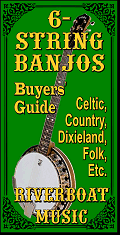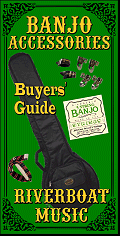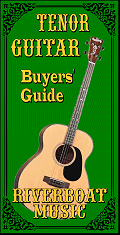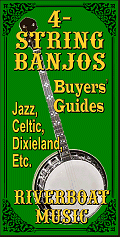Acoustic Instrument
Primers
What Kind of Guitar
Should I Start On?
What Kind of Banjo
Do I Want?
Evaluating and
Buying Used
Guitars
Setting Up
Fretted Instruments Whatever Happened
to the Banjo?
Beginning Five-
String Banjo
6-String Banjos
Banjo Pickups
What is a
Bluegrass Banjo?
What is a
Tenor Guitar?
Dean "Backwoods
Six" Shootout
Axes in my Life
Music Theory
Primers
Introduction
to Scales
Introduction
to Chords
Circle of Fifths
Other Articles
About Music
How to Give
Guitar Lessons
Musician or
Wannabe? Did God Really
Give Rock &
Roll to You?
Are You a
"Brand Bigot"?
Who Owns Folk Songs?
Historical Links
About the
National Road
The Story Behind
the Story - Real
People, Places,
and Events
About the Play
Play Home
What's New
Overview
About the
Music
About the
History
About the
Logistics
About the
Cast
Synopsis
About the
Set
About the
Author
Contact Us
Home

|



|

About 4-String Banjos
| Written by Paul Race for Creek Don't Rise? and School Of The Rock? |
Originating in Africe, the banjo received several enhancements in the early 1800s in the United States. These included a pot (body) and drumhead similar to contemporary snare drums, as well as a fretboard similar to a guitar or mandolin. Though the number of strings was still subject to experimentation, by the late 1800s, it had usually had a drone string, the shorter one closest to the player's chin. The banjo tended to have a fairly long neck. By the time frets were added, the neck tended to have 21 frets, and the scale length (the distance between the nut and the bridge) tended to be between 26 and 27.5 inches.
As banjo size and configuration stabilized for the most part, it tended to be tuned in DBGCg tuning (starting with the string closest to your toes). The drone string, which didn't appear until the 5th fret wasn't usually fretted at all - it just rang on and on, contributing to the banjo's legendary "ring." As long as you were playing in the keys of C or G, it sounded fine. For other keys, it could be tuned up a step or so, but then it would ring on and on as long as you kept that tuning.
But the drone string was more problematic. Both Jazz and Dixieland songs tended to use chords that were "technically" outside of the key of the song. So no matter how you tuned the drone string, the chances were good that it would clash with at least one chord in the song. So Jazz players started leaving the drone string off their banjos. When they ordered new banjos, they ordered ones with only four strings.
The banjo neck also shortened. Some banjos went down to 17 frets, others to 19. Losing the first two frets (the ones by the nut) meant losing almost three inches of overall scale length. 17-fret banjos had even shorter necks, and were popular with people coming over from mandolin. Once they got past the transposition, the rest was easy.
A few Plectrum banjo players changed strings and set their 21-fret banjos up to play ADGC tuning, but they needed to use lighter gauge strings to do so, and the banjos weren't as loud. So that wasn't the most popular solution.
As a side note, the Tenor banjo in ADGC tuning is the highest pitch member of the banjo family (unless you count instruments with mandolin or ukulele necks). A number of Jazz banjo players who wanted more low notes had 6-string banjos made. Today it surprises most people to learn that six-string banjos were an outgrowth of 4-strings, not a crutch for guitar players who didn't want to learn a new instrument. (At the time, hardly anyone played guitar in popular music - banjo and mandolin were both far more popular.)
In fact, the Jazz Tenor banjo spawned one other class of instruments as well. Years after the heyday of the Jazz banjo, when guitar started to be used for Jazz, many Jazz Tenor Banjo players bought 4-string "Tenor" guitars so they could change instruments without having to learn new chords. When I was a kid in the 1960s, there were alomst as many 4-string guitars in the pawn shops as there were 6-string guitars, one legacy of the Jazz Tenor banjo.
In later years, 5-string pickers like Earl Scruggs would use banjos with those added features to make their melody picking loud enough to compete in volume with violins, mandolins, resonator guitars, and snare drums. But most tone ring designs were originally created for 4-string Jazz banjos. In fact quite a few "vintage Gibson Mastertones" you see today (often for astronomical prices) started out as four-strings and got five-string replacement necks when Bluegrass became more popular than Ragtime. Another legacy of the Jazz Tenor banjo.
In Ireland, the idea of 4-string banjos tuned in fifths appealed to fiddle and mandolin players. But instead of using the high ADGC tuning, they put on heavier strings and played their 4-strings an octave down from mandolin (EADG tuning, counting from your knees upward). And so the "Irish Tenor Banjo" was born.
The Irish Tenor Banjo players used a flat pick, but they didn't usually strum all four strings like the Jazz players. For one thing, they were competing with fiddle and mandolin for volume, not with trumpets and trombones. For another, the lower strings on a low-pitched banjo can sound muddy when strummed. But the big reason for picking individual notes instead of strumming was probably that many of the Irish Tenor Banjo players had started on mandolin, and they were used to playing melodies and arpeggios one note at a time.
"Irish Tenor Banjo" picking is still used by Celtic-inspired bands today. In Europe they tend to use 4-string 17- or 19-fret banjos. The earliest hits from bands like Mumford and Sons featured 4-string "Irish" banjo playing arpeggios, and reminded a new generation of American musicians what banjo of any kind "brings to the table." It caused a revival of popularity of banjos of all kinds.
Bands like Gallway's We Banjo Three are currently proving that - with enough talent and practice - you can do almost anything on a 4-string that most people can do on a 5-string, and some they can't. So far there hasn't been a revival of 4-string banjo playing in the United States, but at least there's a little more interest and a lot more acceptance.
If you want to play Jazz, you probably want a 19-fret banjo, because you lose the distantly-spaced frets near the nut, but you keep enough range to do fancy stuff up the neck. That said, you CAN play Jazz on a 21-fret or 17-fret 4-string - hundreds of people do, perhaps thousands.
If you want to play Celtic or most other roots-based music on a four-string, you will probably want to start with "Irish" tuning first. If, later on, someone wants you to join a traditional Jazz or Dixieland band, you can always pick up a second insrument, tune it to Jazz tuning, and learn to transpose "on the fly."
By the way, some manufactures like to pretend that the 17-fret 4-string is the "Irish Tenor" banjo and the 19-fret 4-string is the "Jazz Tenor" banjo, or vice versa. I actually believed them for a bit, but after some observation of real 4-string players in a variety of environments, I've decided that's bull, really. Both kinds of banjo are used almost indiscriminately for both kinds of music. And other kinds as well.
Recently I picked up two old student 4-strings for a demonstration of the different kinds of banjos, including 5- and 6-strings. I tuned one of the 4-strings to Jazz tuning and the other Irish tuning. I planned to sell them again as soon as I had done the talk. But you know what? They are both a LOT of fun to play. Oh well. . . . (The story of that demonstration is here.)
While I was setting the "demo" banjos up, I also examined the different banjo string manufacturers' recommendations for string gauges for 21-fret, 19-fret, and 17-fret banjos and did some experimentation. I don't have the final answer for everyone, but I've published some "starting point" recommendations in Riverboat Music "4-string banjo buyer's guide" here.
Please let us know if you have any questions or if you have any comments about how the 4-string banjo is faring in your part of the world.
Best of luck, all, enjoy your music, and support the arts.
Paul Race
To see our "Buyer's Guide" about 4-string banjos, which includes a bit of information that isn't included in this article, please click here.
All That Jazz
Then Jazz came along. Specifically, the kind of early Jazz that is often called Ragtime. Then white people started writing songs that imitated early Jazz and calling it Dixieland. Both kinds of music depended heavily on the banjo. But Jazz songs tended to be written by trumpet, clarinet, or sax players. Those folks were just as happy to play a song in concert F, Bb, or Eb as they were to play in G or C. So Jazz banjo players started playing chords that fretted all four strings. This allowed them to play in the staccatto styles that Jazz required. It also allowed them to change keys between songs simply by moving their left hand position up and down the neck (the way bass guitar players do today).
Plectrum Banjos
To get the maximum volume and "punch" while playing all those barre chords, Jazz banjo players used "plectrums," similar to today's flat picks. For that reason, a 21-fret 4-string banjo tuned DBGC (starting from your knees upward) was called a "plectrum" banjo. Someone who started on a typical 5-string and went to Plectrum banjo could still use the chords he or she was used to (as long as the songs were in G or C). But those long banjo necks meant that the frets near the nut were pretty far apart, which made Jazz chords there relatively hard. Plus keeping a tuning (like DBGC) that made playing "open chords" easy didn't really buy you anything. So the Plectrum banjo soon gave way to a shorter-necked version with a different tuning.
Tenor Banjos
Soon, Jazz banjo players were tuning their banjos in fifths, like violas (ADGC). That is called "symmetrical" tuning because, unlike guitar or 5-string banjo tuning, the intervals between every string are exactly the same. This makes it easier to play scales and certain kinds of chords anywhere on the banjo neck. (If you play mandolin, you also use a "symmetrical" tuning, so you should know what I'm talking about. The main difference is that a G chord on a mandolin is a C chord on a Jazz Tenor Banjo, and so on.)
Going for Volume
Even strumming banjos with a flatpick didn't always make them loud enough to compete with trumpets, trombones, and saxophones. Resonators, which had been invented earlier, became standard on Jazz banjos, because they reflected the sound from the back of the head out toward the front, instead of letting it get absorbed into the banjo player's belly. Tone rings also became standard. These are rings of metal that go between the banjo's drum head and the wooden "pot," letting the head ring more freely. In their simplest form, they are simply a ring of fat wire, but some of the more elaborate forms are cast of solid bronze and shaped to reflect even more sound forward.
Across the Pond
5-string banjos did beat 4-string banjos to Europe, largely in the form of "Zither" banjos which were played something like classical guitar. But as Jazz crossed the Atlantic, it brought along 4-string and 6-string banjos as well.
So Which 4-String Should I Buy?
As of this writing, there are three common 4-string banjo configurations - 21 fret, 19 fret, and 17 fret. There are also three common 4-string banjo tunings - Plectrum tuning (DBGC), Jazz tuning (ADGC), and Irish tuning (EADG).
About Strings
Am I claiming that just about any 4-string banjo can be used for just about any kind of music? Yes (although Scruggs picking still requires a 5-string). But when you retune from Jazz to Irish banjo tuning or vice versa, you will have to change your strings.
Keep in Touch



Whatever else you get out of our pages, I hope you enjoy your music and figure out how to make enjoyable music for those around you as well.
And please stay in touch!
All material, illustrations, and content of this web site is copyrighted ? 2001, 2002, 2003, 2004, 2005, 2006,
2007, 2008, 2009, 2010, 2011, 2012, 2013, 2014, 2015, 2016 by Paul D. Race. All rights reserved.
Creek Dont' Rise(tm) is a participant in the Amazon Services LLC Associates Program, an affiliate advertising
program designed to provide a means for sites to earn advertising fees by advertising and linking to Amazon.com.
Creek Don't Rise (tm) is Paul Race's name for his resources supporting the history and music of the North American Heartland.
For questions, comments, suggestions, trouble reports, etc. about this page or this site, please contact us.
| Visit related pages and affiliated sites: | |||||
| - Music - | |||||

|
 |
 |

|

|

|

|

|

|

|

|

|

|

|

|

|

|

|
| - Trains and Hobbies - | |||||
 |

|

|  |
 |

|
| - Christmas Memories and Collectibles - | |||||
 |

|
 |

|
 |

|
| - Family Activities and Crafts - | |||||
 |

|

|

|

|

|

